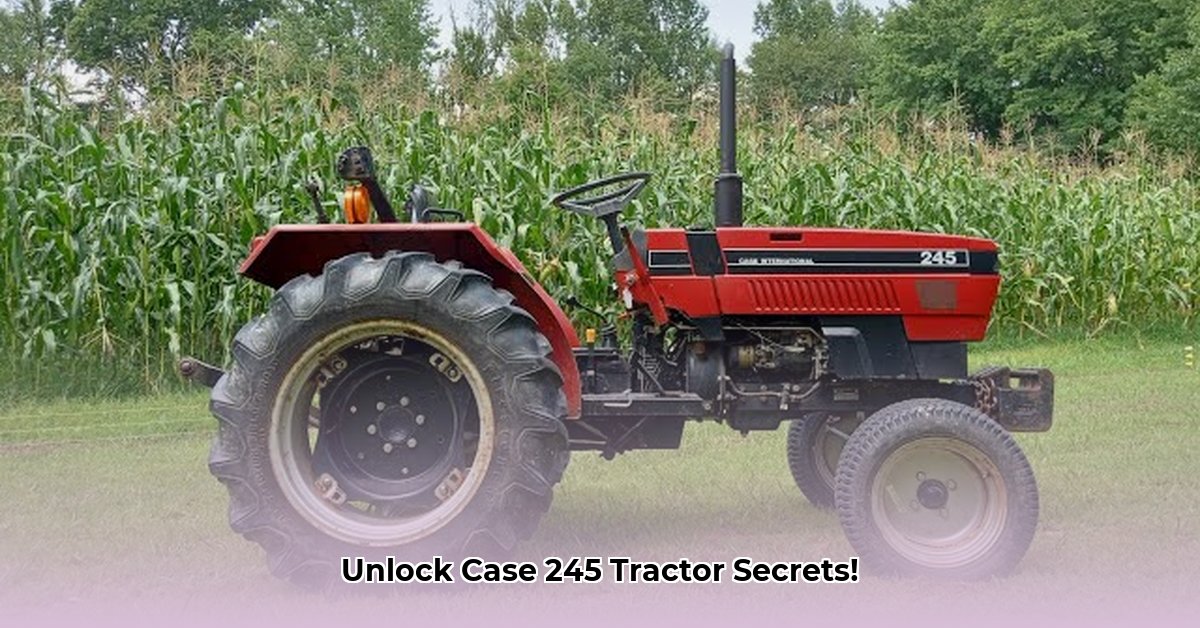
Case 245 Tractor: A Vintage Workhorse
The Case IH 245, a compact utility tractor produced in the 1980s, represents a fascinating blend of vintage charm and robust functionality. Born from a collaboration between Case IH and Mitsubishi, this machine stands as a testament to the engineering prowess of its era. Its compact design and reliable performance make it a sought-after choice for small farms, landscaping, and various light-duty agricultural tasks even today. But what are its specific capabilities? Let's delve into the detailed specifications. Is this rugged machine right for you? For more on Case tractors, check out this helpful resource.
Detailed Specifications: Unpacking the Case 245
The Case 245's strength lies in its balance of power and maneuverability. While not boasting the horsepower of modern tractors, its approximately 21-horsepower Mitsubishi K3D diesel engine provided ample power for its intended applications. This engine, a core component of its reliability, fueled its success throughout the 1980s and continues to draw admiration from vintage tractor enthusiasts. Its compact size, though exact dimensions vary based on configuration, made it ideal for navigating tight spaces and smaller properties; a key advantage that continues to hold relevance.
Power transfer was achieved through either a constant mesh or a synchromesh 9-speed gearbox, offering excellent flexibility for various tasks. The rear lift, capable of handling approximately 1500 pounds at its maximum lift height, allowed for the use of various implements, although the lift capacity does decrease as the lift arms extend—at 24 inches, it drops to around 1125 pounds. This highlights the importance of understanding the context of lift capacity relative to height and planned applications. The tractor’s weight, while not precisely documented here, was relatively modest given its compact nature, aiding in its maneuverability and minimizing ground compaction.
Here's a table summarizing the available data; further research may be needed for complete dimensioning:
| Specification | Approximate Measurement | Notes |
|---|---|---|
| Engine | Mitsubishi K3D Diesel | ~21 hp |
| Transmission | Constant Mesh or Synchromesh 9-speed | Two options available |
| Rear Lift Capacity | ~1500 lbs (max), ~1125 lbs (24") | Varies with lift arm extension |
| Length | Data Needed | Varies slightly based on configuration |
| Width | Data Needed | Varies slightly based on tire choice |
| Height | Data Needed | Varies slightly based on configuration |
| Weight (approximate) | Data Needed | Varies based on options and fuel level |
Understanding these specifications is crucial for evaluating the Case 245's suitability for specific tasks. Remember, always consider the condition and any modifications when assessing a used machine. This thorough specification review allows for informed decision-making, especially when considering potential applications.
Historical Context and Legacy
Manufactured between 1986 and 1990, the Case 245 represents a significant chapter in the Case IH and Mitsubishi partnership. This collaboration resulted in a compact yet reliable tractor well-suited to the needs of small farms and landscaping businesses. Its robust build quality and simple mechanics contributed to its enduring popularity, even today. Given its history and strong performance, it is unsurprising that the Case 245 tractor continues to be a sought-after piece of agricultural history. This fact underscores the importance of carefully considering the machine's history in conjunction with its technical specifications.
Operational Characteristics and Capabilities
The Case 245's compact size and relatively modest horsepower made it ideal for a range of tasks, particularly on smaller properties. Common implements included mowers, tillers, small loaders, and other attachments suitable for its lifting capacity. Its maneuverability was a key advantage in confined spaces; a quality not universally shared by its larger contemporaries. While not designed for heavy-duty tasks – compared with larger agricultural tractors – its balance of power, maneuverability, and reliability made it a practical choice for specific applications. Is its compact size and manageable power output a benefit or detriment to your needs?
Maintenance, Parts, and Restoration
Maintaining a vintage tractor requires a proactive approach. The Case 245, being a discontinued product, presents challenges in sourcing parts. Online marketplaces, salvage yards, specialized dealers, and enthusiast communities are invaluable resources for finding necessary components. The cost of restoration and maintenance can vary greatly depending on the tractor's condition and the extent of needed repairs. However, for those willing to invest time and effort, the rewards of restoring a Case 245 to its former glory are significant.
Current Market Value and Collectibility
The market value of a Case 245 is influenced by several factors, including overall condition, completeness, any unique features or options, and general market demand. Online auctions and interactions with vintage tractor enthusiasts and dealers offer insights into current prices. For collectors, the Case 245 represents a notable piece of agricultural history; its blend of usability and aesthetics makes it a compelling addition to any collection. Are you prepared to invest the time and resources required to restore and maintain a classic like this?
Conclusion: A Vintage Gem
The Case IH 245 remains a noteworthy tractor, offering a compelling combination of history, functionality, and collectability. Its compact design, reliable performance, and relative affordability (considering its vintage) make it an attractive option for various applications. However, prospective owners should carefully weigh the challenges of parts sourcing and potential maintenance costs before purchasing. A thorough understanding of its specifications and history is key to making an informed decision. Is embracing the challenges of vintage machinery worth the rewards?